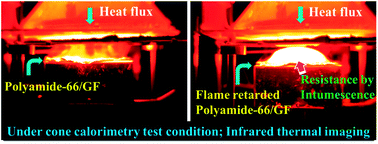Mapping the multimodal action of melamine-poly(aluminium phosphate) in the flame retardancy of polyamide 66†
Abstract
A higher analogue in the melamine polyphosphate family, melamine-poly(aluminium phosphate) (Safire®200), that has shown flame retardancy along with aluminium phosphinate in glass-fibre reinforced polyamide 66 was investigated to elucidate their mode of action. The mechanistic investigation is based on examining the chemical species formed in the condensed and gas phase under different fire scenarios. Samples at different stages of degradation were collected based on the heat release rate (HRR) curve of cone calorimetry and further analysed. Additionally, formulations and flame retardants were also pyrolysed at characteristic temperatures in a tubular furnace based on their thermogravimetric analysis (TGA) profile and investigated. A fire retardancy-quenching mechanism is mapped out on the basis of input from solid state nuclear magnetic resonance spectroscopy (MAS NMR; 27Al, 31P and 13C), Fourier transform Infra-red spectroscopy (FTIR), X-ray powder diffraction (XRD), electron probe microanalysis (EPMA), scanning electron microscopy (SEM), and optical microscopy on degraded samples. Gas phase analysis was studied by TGA coupled FTIR.


 Please wait while we load your content...
Please wait while we load your content...